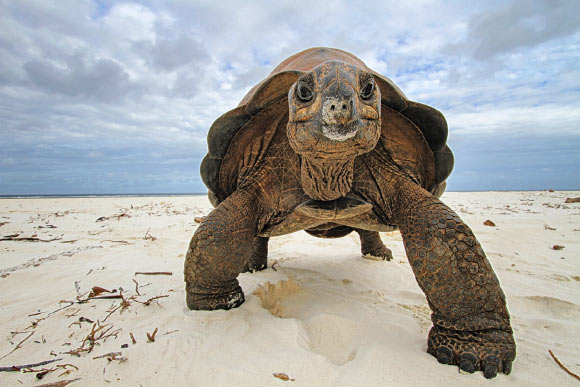Researchers have for the first time assembled the high-quality chromosome-level genome of the Aldabra giant tortoise (Aldabrachelys gigantea), one of only two giant tortoise species left in the world.

The Aldabra giant tortoise (Aldabrachelys gigantea). Image credit: Dennis Hansen, Universität Zürich.
Currently, there are only two extant giant tortoise species, both of which face extinction threats.
Galápagos giant tortoises (Chelonoidis niger and subspecies thereof, formerly Chelonoidis niger species complex) are native to the Galápagos Islands in the Eastern Pacific Ocean, and species of this group are listed as Vulnerable, Endangered, or Extinct according to the IUCN Red List.
Aldabra giant tortoises are endemic to Aldabra Atoll in the Western Indian Ocean.
They can reach a weight of up to 300 kg, and typically live for more than 100 years, with one individual reportedly reaching 250 years of age: if so, that would make it the oldest recorded land vertebrate.
Due to their extremely limited distribution in the wild and the threats posed by climate change, the species is listed as Vulnerable.
Genomes of giant tortoises may harbor clues to their exceptional life history traits such as long life span and gigantism.
“Genomic information is important for breeding efforts in zoos, to maintain the genetic diversity that is present in the wild,” said lead author Dr. Gözde Çilingir, a researcher at the University of Zurich.
“We revealed that most of the genome is similar to other known genomes of Testudines (the order comprising turtles and tortoises).”
“Tortoise species are evolutionarily closely related to each other, and therefore our data will be tremendously helpful not only for the Aldabra tortoise but for all east African and Madagascan tortoises.”
To demonstrate how the new reference genome can be used for practical conservation and breeding efforts, Dr. Çilingir and colleagues determined the sequence of thirty giant tortoises from the wild population and two individuals from the Zurich Zoo.
Using these data in combination with the high-quality reference genome, they were able to determine where in the Aldabra Atoll the zoo-housed animals originally stemmed from.
“We showed that the high-quality resources can be combined with low-coverage resequencing to gain crucial insights into the genetic structure within Aldabra giant tortoises, as well as to resolve the exact origin of zoo-housed individuals,” the authors said.
“Understanding levels of genomic diversity in both native and ex situ populations is crucial to inform rewilding efforts and prioritize conservation efforts.”
“Furthermore, genome-wide analyses of polymorphism can be used to assess the presence of deleterious mutations endangering the long-term health of populations and will allow high-confidence estimates of inbreeding based on runs of homozygosity.”
“Finally, given the exceptionally long life span and large body size of Aldabra giant tortoises, the high-quality genome will inform comparative genomics studies focused on the genetic underpinnings of aging and gigantism.”
The results were published today in the journal GigaScience.
_____
F. Gözde Çilingir et al. 2022. Chromosome-level genome assembly for the Aldabra giant tortoise enables insights into the genetic health of a threatened population. GigaScience 11: giac090; doi: 10.1093/gigascience/giac090







